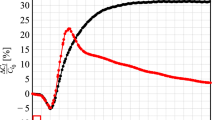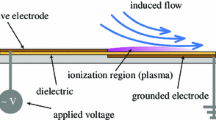Abstract
An experimental investigation has been conducted to demonstrate the utility of active flow control as a disturbance generator for vortex body interaction studies. The technique is used to explore the flow physics of parallel vortex body interaction between two NACA 0012 airfoils in series. Experiments were carried out at a chord-based Reynolds number of 740,000 relative to the first airfoil. Active flow control in the form of nanosecond pulse-driven dielectric barrier discharge plasma actuation, originating close to the leading edge, was used to produce vortex shedding from the upstream (disturbance) airfoil at various frequencies (\(0.038 \le F^+ \le 0.762\)). These vortices were characterized, showing reduced circulation and diameter with increasing frequency, before examining the downstream wake-airfoil interactions. Time-resolved pressure and phase-locked PIV measurements were taken on the downstream (target) airfoil for multiple angles of attack. For \(F^+ \le 0.5\), the target airfoil is subject to strong oscillations from the wake of the disturbance airfoil that lead to large fluctuations in lift and pitching moment. However, a further increase in \(F^+\) reattaches the flow over the disturbance airfoil and no major vortex body interactions are observed on the target. Governing parameters for this type of vortex body interaction are explored, and differences between isolated and non-isolated encounters as well as the presence of a viscous response are examined. Finally, means to alleviate loads caused by the incident vortex are explored.
Graphic abstract




















Similar content being viewed by others
References
Adamovich IV, Little J, Nishihara M, Takashima K, Samimy M (2012) Nanosecond pulse surface discharges for high-speed flow control. In: 6th AIAA flow control conference. https://doi.org/10.2514/6.2012-3137 http://www.scopus.com/inward/record.url?eid=2-s2.0-84880785941&partnerID=tZOtx3y1
Bergh H, Tijdeman H (1965) Theoretical and experimental results for the dynamic response of pressure measuring systems. Tech. rep., National Aero- and Astronautical Research Institute Amsterdam
Booth ER (1990) Experimental observations of two-dimensional blade-vortex interaction. AIAA J 28(8):1353–1359. https://doi.org/10.2514/3.25225
Booth ER, Yu JC (1986) Two-dimensional blade-vortex flow visualization investigation. AIAA J 24(9):1468–1473. https://doi.org/10.2514/3.9467
Caradonna FX, Laub GH, Tung C (1984) An experimental investigation of the parallel blade-vortex interaction. Tech. rep., NASA technical memorandum 86005
Damodaran M, Caugheyf DA (1988) Finite-Volume Calculation of Inviscid Transonic Airfoil-Vortex Interaction. AIAA J 26(11):1346–1353. https://doi.org/10.2514/3.10046
Devinant P, Laverne T, Hureau J (2002) Experimental study of wind-turbine airfoil aerodynamics in high turbulence. J Wind Eng Ind Aerodyn 90:689–707
George A, Chang SB (1984) Flow field and acoustics of two-dimensional transonic blade-vortex interactions. In: 9th AIAA aeroacoustics conference
Greenblatt D, Wygnanski IJ (2000) The control of flow separation by periodic excitation. Prog Aerosp Sci 36(7):487–545. https://doi.org/10.1016/s0376-0421(00)00008-7
Gursul I, Rockwell D (1990) Vortex street impinging upon an elliptical leading edge. J Fluid Mech 211(Davenport 1977):211–242. https://doi.org/10.1017/S0022112090001550
Horner MB, Saliveros E, Kokkalis A, Galbraith RAMD (1993) Results from a set of low speed blade-vortex interaction experiments. Exp Fluids Exp Methods Appl Fluid Flow 14(5):341–352. https://doi.org/10.1007/BF00189493
Kalkhoran IM, Seath DR (1989) An experimental investigation of the parallel vortex-airfoil interaction at transonic speeds. In: AIAA 20th fluid dynamics, plasma dynamics and lasers conference
Kitaplioglu C, Caradonnna F, Burley C (1997) Parallel blade-vortex interactions: an experimental study and comparison with computations. J Am Helicopter Soc 42:272–281
Little J (2019) Localized thermal perturbations for control of turbulent shear flows. AIAA J 57(2):655–669
Little J, Singh A, Ashcraft T, Durasiewicz C (2019) Post-stall flow control using nanosecond pulse driven dielectric barrier discharge plasma actuators. Plasma Sourc Sci Technol 28(1):014002. https://doi.org/10.1088/1361-6595/aaf52f
McCroskey P, Goorjian WJ (1983) Interactions of airfoils with gusts and concentrated vortices in unsteady transonic flow. In: AIAA 16th fluid and plasma dynamics conference
Meier GEA, Timm R (1985) Unsteady vortex airfoil interaction. In: Unsteady aerodynamics–fundamentals and applications to aircraft dynamics
Nakagawa T (1988) On unsteady airfoil-vortex interaction. Acta Mech 75(1–4):1–13. https://doi.org/10.1007/BF01174624
Nakamura Y (1981) Prediction of blade-vortex interaction noise from measured blade pressure. Tech. rep., NASA Technical Memorandum 81320
Peng D (2014) Vortex dynamics and induced pressure/load fluctuations during blade-vortex interactions. Dissertation, The Ohio State University
Peng D, Gregory JW (2015) Vortex dynamics during blade-vortex interactions. Phys Fluids. https://doi.org/10.1063/1.4921449
Peng D, Gregory JW (2017) Asymmetric distributions in pressure/load fluctuation levels during blade-vortex interactions. J Fluids Struct 68:58–71. https://doi.org/10.1016/j.jfluidstructs.2016.10.008
Rival D, Manejev R, Tropea C (2010) Measurement of parallel blade-vortex interaction at low Reynolds numbers. Exp Fluids 49(1):89–99. https://doi.org/10.1007/s00348-009-0796-1
Rockwell D (1998) Vortex-body interactions. Annu Rev Fluid Mech 30(1):199–229. https://doi.org/10.1146/annurev.fluid.30.1.199
Seath D, Kim JM, Wilson DR (1989) Investigation of the parallel blade-vortex interaction at low speed. J Aircraft 26(4):328–333. https://doi.org/10.2514/3.45764
Srinivasan GR, McCroskey WJ, Baeder JD (1986) Aerodynamics of two-dimensional blade-vortex interaction. AIAA J 24(10):1569–1576. https://doi.org/10.2514/3.9486
Straus J, Renzoni P, Mayle RE (1990) Airfoil pressure measurements during a blade vortex interaction and a comparison with theory. AIAA J 28(2):222–228. https://doi.org/10.2514/3.10378
Stremel PM (1989) Aerodynamic interaction between vortical wakes and lifting two-dimensional bodies. Tech. rep., NASA Technical Memorandum 101074
Strike JA, Hind MD, Saini MS, Naughton JW, Wilson MD, Whitmore SA (2010) Unsteady surface pressure reconstruction on an oscillating airfoil using the wiener deconvolution method. In: 27th AIAA aerodynamic measurement technology and ground testing conference, pp 1–12. https://doi.org/10.2514/6.2010-4799
Svärd M, Lundberg J, Nordström J (2010) A computational study of vortex-airfoil interaction using high-order finite difference methods. Comput Fluids 39(8):1267–1274. https://doi.org/10.1016/j.compfluid.2010.03.009
Thom A, Duraisamy K (2010) High-resolution simulation of parallel blade-vortex interactions. AIAA J 48(10):2313–2324. https://doi.org/10.2514/1.J050381
Weingaertner A, Tewes P, Little JC (2018) Parallel vortex body interaction enabled by active flow control. In: 2018 flow control conference. https://doi.org/10.2514/6.2018-3521. https://arc.aiaa.org/doi/abs/10.2514/6.2018-3521
Widnall SE (1971) Helicopter noise due to blade-vortex interaction. J Acoust Soc Am 50(1B):354. https://doi.org/10.1121/1.1912640
Wilder MC, Telionis DP (1998) Parallel blade-vortex interaction. J Fluids Struct 12:801–838
Acknowledgements
This work was supported by the Army Research Office under ARO grant No. W911NF-14-1-0662 monitored by Dr. Matthew Munson. The authors would like to acknowledge Zachary Morrett and Jorge Castro Maldonado for their continuous effort throughout the project, as well as all other members of the Turbulence and Flow Control Laboratory. Special thanks go to the AME Machine Shop (Dale Drew, Lane Hammond, and Joe Hartley) for their ongoing support.
Author information
Authors and Affiliations
Corresponding author
Additional information
Publisher's Note
Springer Nature remains neutral with regard to jurisdictional claims in published maps and institutional affiliations.
Rights and permissions
About this article
Cite this article
Weingaertner, A., Tewes, P. & Little, J.C. Parallel vortex body interaction enabled by active flow control. Exp Fluids 61, 137 (2020). https://doi.org/10.1007/s00348-020-02962-2
Received:
Revised:
Accepted:
Published:
DOI: https://doi.org/10.1007/s00348-020-02962-2




